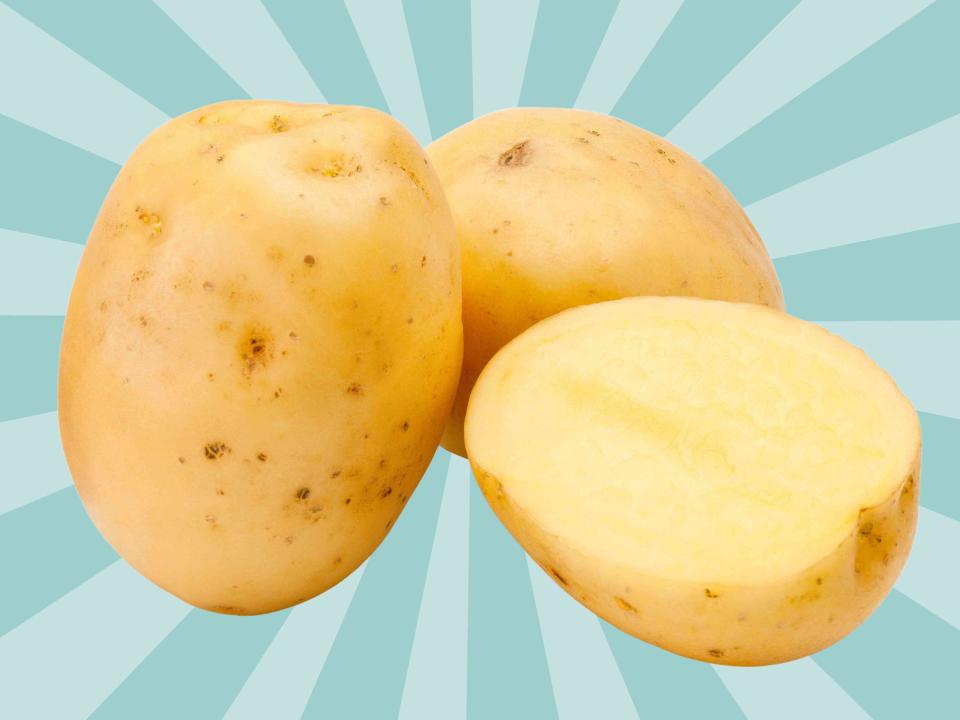PSA: You Should Be Stocking Up On New Potatoes ASAP—Here's Why
Learn all about new potatoes, including what they are and what to do with them.

Hyrma
Chances are, if you’ve frequented a farmers’ market in the warmer months or eaten at a nicer restaurant during that time, you’ve come across the words “new potatoes.” You may have wondered, “Have I been buying old ones this whole time?”
Potatoes, as a whole, tend to look anything but new—but then again, just about anything grown underground in the dirt will have a hard time looking bright and shiny. So maybe the restaurant got their potatoes fresh that day and called them new? Or are they a new breed? As it turns out, it’s nothing of the sort.
What Are New Potatoes?
When it comes to spuds, “new” doesn’t mean “recent” or “fresh” as much as it means “young.” Have you ever seen a newborn baby out and about and commented (either aloud or in your head) “Oh my goodness, you’re brand new!”? That’s the brand of “new” we’re talking about with potatoes—young. Fittingly, another name for them is "baby.”
New potatoes are plucked from the ground while immature and still small, meaning they’ll be sweeter and laden with moisture, sporting a bit more of a sheen than a dull shell (especially once washed, of course). Appropriately, these potatoes are ready in the spring and summer, popping up on menus when the seasons and other wildlife and plants renew themselves.
To be clear, these aren’t a unique variety of potato. New potatoes can be any kind of potato, as long as they’re harvested early in the season. Since potatoes are often placed in the cold weather category of ingredients, eating these small, waxy, bright little nuggets in warmer temperatures can feel brand new in itself.
With a thin pop to their skin, a lower starch level than their full-grown brothers, and the handy ability to stay intact when cooked, new potatoes are ideal for room temperature dishes, roasting, or a potato salad, but not so great for mashed potatoes. Instead, try smashing them individually once boiled—the lazy day approach—and drizzling them with an infused olive oil.

DOTDASH MEREDITH FOOD STUDIOS
What Do New Potatoes Taste Like?
If you’ve ever delighted in homegrown tomatoes or freshly picked corn and marveled at the sweetness and freshness in comparison to others, that’s a new potato. These mellow and moisture-filled spuds will taste incredibly different than that large russet that’s been resting in your pantry’s potato sack for weeks.
New Potatoes vs. Fingerling Potatoes
Fingerling (and red) potatoes have the most in common with new potatoes. They’re small in size, don’t need to be peeled to be used, hold up well in a variety of cooking methods, and have a creamy texture and taste. Their similar appearances and uses in dishes cause them to often be mistaken for one another.
There are really only two differences between new and fingerling potatoes. First, fingerling potatoes are their own variety, whereas new potatoes might refer to any type of potato. Second, fingerlings are fully mature while new potatoes are young.
How to Cook New Potatoes
You are just a quick and gentle wash away from enjoying these little nuggets. The skin is so thin, your peeler can remain safely stowed in its drawer (but it’s also OK if washing them coaxes the skin off a bit or if bits of it were already flaking off when you bought them).
Use your new potatoes in plenty of recipes:
Boiled with butter and herbs
With a pot roast
In a stew
In a fresh side dish
With green beans
In a slow cooker
In an air fryer
For an easy sheet pan meal
Alongside fish
For hassleback potatoes
In a seafood boil
On a kabob
With asparagus
Grilled
Steamed
Any room temperature preparation

How to Store New Potatoes
Because of their higher moisture content and thinner skin, new potatoes don’t store quite as well or nearly as long as their more mature counterparts. A paper bag or loose plastic wrap is ideal, and they should be used within a few days of being bought. Don’t let the new get, well, old.
Like all potatoes, don’t wash them before storing. Allow any residual dirt to keep them fresh. (Water will just encourage softening or bruising.) The longer you store them, the more they’ll be tempted to get starchy, losing the appeal of their signature texture.
Make sure sunlight is out of the picture, that they have plenty of air circulation, are nice and cool, and are kept separate from other fruits or vegetables. They’re a bit high-maintenance, but hey, so are newborns.
Read the original article on All Recipes.


